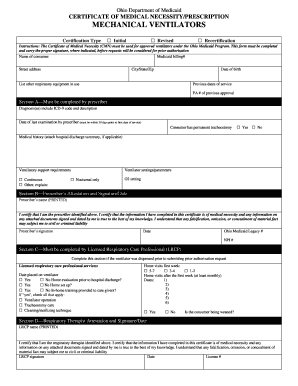
MECHANICAL VENTILATORS Form


What are mechanical ventilators?
Mechanical ventilators are medical devices designed to assist or replace spontaneous breathing in patients who are unable to breathe adequately on their own. These devices are commonly used in hospitals, particularly in intensive care units, to provide respiratory support for patients with conditions such as respiratory failure, severe pneumonia, or chronic obstructive pulmonary disease (COPD). Mechanical ventilators work by delivering a controlled flow of air or oxygen into the lungs, ensuring that the patient receives the necessary ventilation to maintain adequate oxygen levels in the blood.
How to use mechanical ventilators
Using mechanical ventilators involves several key steps to ensure proper functioning and patient safety. First, healthcare professionals must assess the patient's respiratory needs and select the appropriate ventilator settings based on their condition. This includes determining the tidal volume, respiratory rate, and oxygen concentration. Next, the ventilator is connected to the patient through an endotracheal tube or a tracheostomy tube. Continuous monitoring of the patient's vital signs and ventilator parameters is essential to adjust settings as needed and to respond to any complications that may arise during ventilation.
Legal use of mechanical ventilators
The legal use of mechanical ventilators is governed by various regulations and guidelines to ensure patient safety and quality of care. In the United States, healthcare facilities must comply with standards set by organizations such as the Joint Commission and the Centers for Medicare & Medicaid Services (CMS). These regulations include proper training for healthcare staff, maintenance of equipment, and adherence to infection control protocols. Additionally, informed consent from patients or their legal representatives is required before initiating mechanical ventilation, outlining the risks and benefits associated with the procedure.
Key elements of mechanical ventilators
Mechanical ventilators consist of several critical components that work together to provide effective respiratory support. Key elements include:
- Control system: This allows healthcare providers to set and adjust ventilator parameters.
- Breathing circuits: These deliver air or oxygen to the patient and remove exhaled carbon dioxide.
- Monitoring systems: These track the patient's respiratory status and ventilator performance, providing real-time data for adjustments.
- Alarm systems: These alert healthcare providers to any issues, such as disconnections or changes in patient condition.
Steps to complete the mechanical ventilators setup
Setting up a mechanical ventilator involves several systematic steps to ensure proper operation and patient safety:
- Gather all necessary equipment, including the ventilator, breathing circuits, and patient interface.
- Perform a pre-use check on the ventilator to ensure it is functioning correctly.
- Connect the ventilator to a power source and ensure it is properly calibrated.
- Set the appropriate ventilator parameters based on the patient's needs.
- Connect the breathing circuit to the ventilator and the patient interface securely.
- Monitor the patient closely after initiating ventilation to ensure effective respiratory support.
Examples of using mechanical ventilators
Mechanical ventilators are utilized in various clinical scenarios, including:
- Patients undergoing surgery who require temporary respiratory support during anesthesia.
- Individuals with acute respiratory distress syndrome (ARDS) needing assistance in oxygenation and ventilation.
- Chronic respiratory disease patients experiencing exacerbations that compromise their ability to breathe.
- Patients in critical condition who are unable to maintain adequate ventilation due to neurological impairment.
Create this form in 5 minutes or less
Related searches to MECHANICAL VENTILATORS
Create this form in 5 minutes!
How to create an eSignature for the mechanical ventilators
How to create an electronic signature for a PDF online
How to create an electronic signature for a PDF in Google Chrome
How to create an e-signature for signing PDFs in Gmail
How to create an e-signature right from your smartphone
How to create an e-signature for a PDF on iOS
How to create an e-signature for a PDF on Android
People also ask
-
What are MECHANICAL VENTILATORS and how do they work?
MECHANICAL VENTILATORS are devices that assist or replace spontaneous breathing in patients who are unable to breathe adequately on their own. They deliver a controlled flow of air and oxygen to the lungs, ensuring that patients receive the necessary respiratory support. Understanding how MECHANICAL VENTILATORS function is crucial for healthcare providers to ensure optimal patient care.
-
What features should I look for in MECHANICAL VENTILATORS?
When selecting MECHANICAL VENTILATORS, consider features such as adjustable settings for tidal volume, pressure support, and oxygen concentration. Additionally, look for user-friendly interfaces and advanced monitoring capabilities that provide real-time data on patient status. These features enhance the effectiveness and safety of MECHANICAL VENTILATORS in clinical settings.
-
How do MECHANICAL VENTILATORS benefit patients?
MECHANICAL VENTILATORS provide critical respiratory support for patients with severe respiratory distress or failure. They help maintain adequate oxygenation and carbon dioxide removal, which is vital for recovery. By using MECHANICAL VENTILATORS, healthcare providers can stabilize patients and improve their chances of survival.
-
What is the pricing range for MECHANICAL VENTILATORS?
The pricing for MECHANICAL VENTILATORS can vary widely based on features, brand, and technology. Basic models may start around a few thousand dollars, while advanced ventilators with specialized features can cost signNowly more. It's essential to evaluate your specific needs and budget when considering MECHANICAL VENTILATORS.
-
Are MECHANICAL VENTILATORS easy to integrate with existing hospital systems?
Many modern MECHANICAL VENTILATORS are designed to integrate seamlessly with existing hospital systems, including electronic health records (EHR) and monitoring systems. This integration allows for better data management and enhances the overall efficiency of patient care. Ensure that the MECHANICAL VENTILATORS you choose are compatible with your current infrastructure.
-
What training is required for staff to operate MECHANICAL VENTILATORS?
Operating MECHANICAL VENTILATORS requires proper training to ensure patient safety and effective use. Healthcare providers should undergo training programs that cover the operation, troubleshooting, and maintenance of these devices. Familiarity with MECHANICAL VENTILATORS is essential for staff to respond effectively in critical situations.
-
Can MECHANICAL VENTILATORS be used in home care settings?
Yes, some MECHANICAL VENTILATORS are designed for home care use, providing patients with the necessary respiratory support in a comfortable environment. These devices are typically more portable and user-friendly, allowing caregivers to manage patient needs effectively. It's important to consult with healthcare professionals to determine the suitability of MECHANICAL VENTILATORS for home use.
Get more for MECHANICAL VENTILATORS
- Motor vehicle bill of sale through public auction form dot gov nt
- Instructions for form it 21059 taxnygov
- Delaware state tax filing free tax usa form
- Division of revenue form
- Form or 20 inc instructions oregon corporation income tax
- Form or ps care provider statement 150 cloudfrontnet
- How to fill out form 2553 step by step taxes s2e62
- 2022 insurance premium tax information
Find out other MECHANICAL VENTILATORS
- eSignature Oregon Car Dealer Rental Lease Agreement Safe
- eSignature South Carolina Charity Confidentiality Agreement Easy
- Can I eSignature Tennessee Car Dealer Limited Power Of Attorney
- eSignature Utah Car Dealer Cease And Desist Letter Secure
- eSignature Virginia Car Dealer Cease And Desist Letter Online
- eSignature Virginia Car Dealer Lease Termination Letter Easy
- eSignature Alabama Construction NDA Easy
- How To eSignature Wisconsin Car Dealer Quitclaim Deed
- eSignature California Construction Contract Secure
- eSignature Tennessee Business Operations Moving Checklist Easy
- eSignature Georgia Construction Residential Lease Agreement Easy
- eSignature Kentucky Construction Letter Of Intent Free
- eSignature Kentucky Construction Cease And Desist Letter Easy
- eSignature Business Operations Document Washington Now
- How To eSignature Maine Construction Confidentiality Agreement
- eSignature Maine Construction Quitclaim Deed Secure
- eSignature Louisiana Construction Affidavit Of Heirship Simple
- eSignature Minnesota Construction Last Will And Testament Online
- eSignature Minnesota Construction Last Will And Testament Easy
- How Do I eSignature Montana Construction Claim